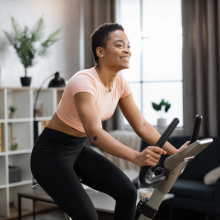When it comes to keeping fit, I'm a simple girl: all I really need is a basic stationary bike (my go-to cost me less than $200), a yoga mat, a few sets of weights, resistance bands, and a YouTube fitness instructor I've grown to love. That's precisely why when I was offered the chance to try out the NordicTrack S22i Studio Bike, I was thrilled. After all, who would pass on the chance to trial a commercial-level bike that looked straight out of an Equinox cycling class?
I took advantage of NordicTrack's white glove delivery option: a perk that can't really be called a "perk," since it isn't free. If you want your bike to be assembled in the room of your choice, you have to drop an extra $199 for the service. It's not exactly a lightweight item (weighing 205 pounds in its box), so I was personally grateful for any setup help I could get and excited to finally power up this baby. Little did I know that this was when I'd encounter roadblock No. 1.
The NordicTrack software is slow and glitchy
Be warned: Using the NordicTrack requires a significant time investment beyond what you usually factor in for workouts, given that its software takes a considerably long time to load. When powering on the bike (via an on/off switch that's inconveniently located on the bottom part of the NordicTrack), the screen lights up almost instantly but then takes about three to five minutes to actually display the home navigation. After that, it takes another few minutes to load any given workout program you've selected — often displaying the menacing word "buffering" when you're in a rush and just want to start pedaling.
To be fair, NordicTrack is jam-packed with workout series that take you along for rides in Norway, Spain, Hawaii, and beyond; professionally filmed strength or yoga classes that you can do off the bike, led by top instructors like Kayla Itsines; and detailed charts showcasing your fitness progress. The quantity of such content excuses the software's loading time partially, but a girl can only wait so long for a rotating circle on the screen to stop rotating before she gets pissed.
Even when a NordicTrack program did load for me, the visuals of the rides (during which you follow an instructor along as they cycle through a scenic destination) weren't as clear and crisp as I expected. It was still heartwarming to see Barcelona again after I traveled there a few years ago, but I was hoping to get a slightly less pixelated experience.

Workout programs have other flaws
It's important to note that, while every NordicTrack purchase comes with a one-month free trial of the iFit individual membership (iFit being the workout platform that the bike operates on), you do have to pay for access going forward. To be exact, the subscription tiers break down as follows:
Individual monthly membership: $15/month
Individual yearly membership: $180/year
Family monthly membership: $39/month
Family yearly membership: $396/year
A family membership holder can add up to four additional users while individual memberships accommodate one user.
While I had my free trial of iFit, I made sure to make good use of it by sampling the various ways one could work out on a NordicTrack. One of the first workouts I did was the first video in the "Norwegian Weight Loss Series," which promised to auto-adjust my incline and resistance levels on the bike based on previous cycling patterns. A friendly, if too peppy, instructor introduced herself and then we were off, cycling on a path around a pretty lake in Norway. The terrain was homogenous and uneventful, though it was funny to see Norwegians strolling around while being unwitting participants in the filming of this workout.
Throughout the ride, the bike constantly toyed with my incline (it has a -10 percent to 20 percent incline range) and resistance (there are 24 levels of it in total) — to provide the intervals that factored into the "weight loss" component of the series. When an incline was too small for me, or resistance too much, I tried to reverse the changes manually by clicking buttons on the handles of the bike (another option is to toggle resistance/incline on the actual screen). These were promptly undone by the system, so it was no use creating my own conditions for the ride. Occasionally, my holistic progress was shown on the map — letting me know just how much longer I needed to push myself for, while the instructor continued calling out her Soulcycle-esque motivational phrases.

I usually factor only 20 minutes of cardio into my daily exercise routine, so I jumped off the bike a little before the first video in the workout series ended. Strangely, the video kept playing and the minutes kept accumulating; in other words, NordicTrack didn't sense that I was done working out — not before I physically pressed the stop button on the screen to prompt the cooldown.
During a Barcelona ride that promised a scenic ascent to Tibidabo — a hill overlooking the whole city — a different instructor offered target RPM (revolutions per minute) suggestions and encouraged me to continue pedaling. "You can do hard things," she preached, and I cycled a little faster. She then promised that there was a beautiful lake somewhere along our route, so I cycled even faster. When we reached the final destination, no such lake manifested. In fact, the camera didn't spin at all to allow NordicTrack users to take in the view (as they would if they'd just cycled to the top of the hill in real life).
User ratings and comments for this particular video reflected my disappointment: "Telling us the history is better than how to move legs," one said. "Great HIIT but we didn't find the lake?" another questioned.
I gave iFit's Global Workouts — all of them shot on location — one more chance, with a ride in Monteriggioni. I was expecting a ride inside the walls of this fortified Tuscan town but instead spent half an hour riding on a surrounding road — with direction signs and the occasional Italian flag serving as the only landmarks worth noting. This is something I'd definitely change about NordicTrack workout programs: Most of them have quite clickbaity and misleading thumbnails, and it would be great if the actual routes riders are taken on lived up to the promises.

An innovative Google Maps feature
Despite all this, I did have a favorite feature of the NordicTrack S22i Studio Bike: mapping your own workouts with Google Maps. By clicking the "create" option on your screen menu, you can type in any place in the world on the map and then set your own cycling parameters there: choosing either an out-and-back ride or a loop. The incline and resistance on your bike are then adjusted to match real-life terrain; this time, though, you can toggle with them manually without the machine reversing your changes. This feature is great for athletes who are training for upcoming races in places where they haven't physically biked, but it's also absolutely life-changing for anyone who misses a particular location, be it their childhood town, the streets around their first apartment, or the park where they had a first date with the love of their life.
I cycled around Kyiv — where I spent a good chunk of my childhood — and Rivne, Ukraine, where my mom grew up. It was nostalgia-inducing and mind-boggling in the best ways. I was captivated by sights of streets I remembered and even a glimpse of my mom's past house — so much so that my workout passed in the blink of an eye.
I truly applaud this particular capability of the NordicTrack bike — one of the only fitness equipment companies to have the Google Maps feature on its roster. Still, iFit's intention with the feature was way better than its actual execution.
Essentially, the screen showed a series of progressive Google Maps images, rather than allowing you to smoothly experience Street View. At some points, it looked like you were cycling into traffic, which was honestly a little unsettling. On other occasions, I was notified that there weren't any visuals for a particular coordinate on the map. The weirdest part was definitely getting a full-on view of someone's apartment in Ukraine. I'm not sure how Google Maps acquired that image, but it was the hardest I have ever laughed on a stationary bike before.


Uncomfy seat, difficulty reaching the screen
Now that I've sufficiently described NordicTrack's software (specifically, iFit's fitness offerings and some of its major flaws), I want to touch on the topic of the bike itself. There's no denying that it's sexy and sleek. It looks really good in your bedroom or living room or wherever you choose to set it up. It also has handlebars and a seat you can adjust (bringing the latter either forward or back, up or down depending on what suits you).
Yet, this saddle isn't for the sensitive. Indeed, it's made of such tough material that you can easily bruise your bum after a 40-minute ride — requiring you to invest in a gel bike seat cushion like this one from Zacro to prevent the soreness.
Another of the NordicTrack S22i Studio Bike's design flaws is the fact that, for short kings especially, the screen is kind of hard to reach from your seat without raising yourself out of the saddle and leaning toward it. Since everything hinges on being able to use the 22-inch smart HD touchscreen, this is a big issue: one that can't be solved, it seems, even by adjusting the handles to their closest position and the seat to its highest. Since we're on the topic of screens, while NordicTrack does advertise its screen as a rotating one (which can help you partake in those off-the-bike activities I mentioned before, like yoga or ab burnouts and the occasional meditation session), mine did no such thing... which is still a mystery to me.
As for NordicTrack's major wins when it comes to design, its music options, built-in fan, included dual three-pound dumbbells, and smooth Silent Magnetic Resistance system all make the list.
To break it down, you can either jam out to your favorite bops and listen to what the instructor is saying via your own headphones (which easily connect to the machine on Bluetooth) or amplify your songs through the actual bike — which has pretty impressive and rich sound levels. If sweating to a personal Spotify playlist isn't your thing, NordicTrack offers its own selection of songs, which I found quite unusual and diverse (charlieonafriday and BLACKPINK were on aux, to name a few artists).
The fan feature came with multiple intensity settings and was quite a godsend during some of the hottest weeks on record, while the dumbbells were helpful for keeping my upper bod engaged (though I found them to be a bit too light for my tastes). Lastly, the SMR system — NordicTrack's token innovation — keeps your ride quiet and akin to pedaling through butter. Even when I stood up on my pedals for some intervals of time, the resistance never felt rickety or unstable. FYI: The S22i has hybrid SPD and toe clip pedals instead of standard pedals (which essentially means you can wear normal sneakers when cycling or use SPD-compatible, clip-in cycling shoes that aren't included with the purchase).

The verdict
Considering the fact that the NordicTrack S22i Studio Bike costs more than a plane ticket to some destinations available in the iFit app, I really wanted to like it, I did. It took me weeks to sample the bike's different offerings, and some of them were objectively impressive. Still, the studio bike's performance in no way lives up to its price, which is why I rated it pretty low in the "bang for the buck" and "performance" categories.
If instructor-led sessions with detailed performance metrics are important in your own cycling routine — and you're someone who's motivated by a swanky, tactile, immersive screen or collecting badges that show up on your machine and the compatible iFit phone app — this NordicTrack might not be a bad option. It's a solid competitor to other feature-packed stationary bikes on the market, from brands like BowFlex, Equinox+, and, of course, the quintessential Peloton.
On the other hand, for those of us who are more worried about fitness equipment helping achieve physical results (versus how cool it looks or if it allows you to virtually experience Patagonia), perhaps a bike in the $100 to $500 range will serve the purpose. After all, the money you save could be used toward a trip to cycle in actual Patagonia.
Topics Reviews Fitness Tech Fitness Equipment



























